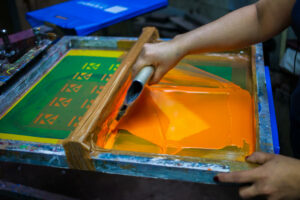Silk screening, a versatile printing technique with roots tracing back to ancient China, has evolved into a dynamic art form and commercial process. While beginners often start with the basics of silk screening, there’s a world of advanced techniques waiting to be explored by seasoned practitioners. In this guide, we’ll delve into some of these advanced techniques, offering insights and tips to take your silk screening projects to the next level.

Multicolor Printing
While single-color prints are common in silk screening, mastering multicolor printing opens up a realm of creative possibilities. Achieving crisp, precise registration between colors is essential for successful multicolor prints. Techniques such as pin registration, which involves aligning registration marks on each color separation, can help ensure accurate alignment. Additionally, experimenting with halftones and blends can add depth and dimension to your multicolor designs.
Specialty Inks and Effects
Beyond traditional plastisol and water-based inks, there’s a vast array of specialty inks and effects to explore in silk screening. Metallic and fluorescent inks can impart a striking sheen or luminous glow to your prints, while glow-in-the-dark inks add an element of surprise and intrigue. Other effects, such as puff, foil, and high-density printing, offer tactile and visual enhancements that elevate your designs. Experimenting with different ink formulations and application techniques can yield stunning results.
Overprinting and Layering
Overprinting involves printing one color on top of another to create new colors or visual effects. By strategically layering translucent inks, you can achieve rich, complex color combinations and textures. Overprinting can also be used to create depth and dimension in your designs, adding visual interest and complexity. Experiment with different ink combinations and printing sequences to discover unique overprinting effects that enhance your artwork.
Discharge and Resist Printing
Discharge printing involves removing or bleaching out the dye from dyed fabrics, leaving behind a lighter color or pattern. This technique can be used to create subtle, tonal prints on dark-colored garments or to achieve distressed or vintage effects. Resist printing, on the other hand, involves applying a resist agent to the fabric before printing, creating a barrier that prevents the ink from adhering to certain areas. This allows for intricate and detailed designs with crisp, clean lines.
Photographic and Photorealistic Printing
Advancements in screen-making technology have made it possible to achieve photographic and photorealistic prints in silk screening. Using high-resolution screens and specialized techniques such as simulated process printing or four-color process printing, you can reproduce photographic images with remarkable accuracy and detail. While challenging, mastering these techniques opens up exciting possibilities for creating lifelike prints with vibrant colors and subtle gradients.
Conclusion
Advanced silk screening techniques offer endless opportunities for creative expression and experimentation. Whether you’re pushing the boundaries of multicolor printing, exploring specialty inks and effects, or mastering intricate printing processes, the journey towards mastery is both challenging and rewarding. By embracing innovation, honing your skills, and pushing the limits of the medium, you can unlock new dimensions of creativity in your silk screening projects.
